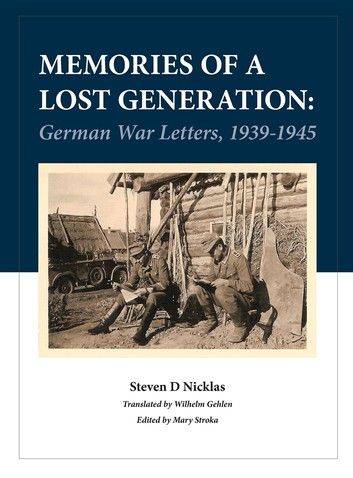| FindBook |
|
有 1 項符合
Wilhelm Gehlen的圖書 |
 |
$ 300 電子書 | Memories of a Lost Generation
作者:Steve Nicklas / 譯者:Wilhelm Gehlen 出版社:Steven Nicklas 出版日期:2017-11-20 語言:英文  看圖書介紹 看圖書介紹
|
|
|
This book is a detailed history of the German side of World War 2. It is based on letters from German soldiers and German families. The study collection consisted of a total of 564 different letters and documents which included: 544 private letters, from a total of 72 different individuals; 18 official letters and documents; and two wartime diaries.
To maintain a statistically valid, unbiased sample, the contents of the letters were translated after they were selected for use in the study. The selection of the letters for inclusion was based solely on the unit identification of the individuals who wrote the letters, all of which were written between 1937and 1945.
Facsimile images of all original letters and documents presented in the text are available to the reader. The large number of pages (just over 2,000) in the corpus mitigates against the use of a traditional appendix. Scanned color copies of all original letters and other documents referenced in the text can be found on the following permanent website: www.germanwarletters.com. All correspondence and documents are numbered consecutively to match their appearance in the text.
The letters come from just about every branch of the German military, the Nazi political establishment, and the civilian population. Included in the corpus are letters to and from soldiers in the Wehrmacht, the Luftwaffe, the Kriegsmarine, the Waffen SS, the SD, the RAD, Pioneer Units, a punishment battalion, and concentration camps. The documents were, however, selected on the basis of content. In some cases, they relate directly to situations mentioned in the letters.
A total of 416 letters (from nine soldiers) tell the wartime story of two extended families, the Bredemeiers and the Ketschaus. The translations of 370 of these letters are included in this volume. The remaining 46 letters were translated and read but not included in the text because of repetition and brevity. Letters from additional families are present in the collection as well, but they are fewer in number and, as a result, they cover shorter periods of time.
In addition to the family correspondence, a number of single letters are included. For the most part, they are from important individuals or military units and provide unique personal insight into many major wartime events. Not all of the letters contain important historical information or descriptions of battles fought; some tend to be more mundane and deal with the daily issues of life during the war. Some will make you laugh; some will make you cry. Taken as a whole, however, they make it clear that the majority of the soldiers who wrote the letters seem to have been motivated by a sense of duty, tradition, patriotism and in some cases, fear.
Throughout this book, I maintain that the best way to gain insight into the wartime mindset of German soldiers and their families is through the reading of their letters. Many letters contain descriptions of battles won and lost and provide details that can be used to supplement existing accounts of these engagements. In addition to battle specific information, the letters are a treasure trove of general knowledge about life at the front. Collectively they contain many bits of significant information, everything from the use of artificial fog machines to obscure Volkswagen factories to the importance of food and clothing shipments from home. Many letters are hard to forget; the emotions of a mother desperate for any word from her son missing on the Russian Front, or the farewell letter written by a soldier to his girlfriend on the eve of the Battle of Berlin.
|











